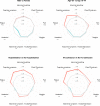Incidence, co-occurrence, and evolution of long-COVID features: A 6-month retrospective cohort study of 273,618 survivors of COVID-19
- PMID: 34582441
- PMCID: PMC8478214
- DOI: 10.1371/journal.pmed.1003773
Incidence, co-occurrence, and evolution of long-COVID features: A 6-month retrospective cohort study of 273,618 survivors of COVID-19
Abstract
Background: Long-COVID refers to a variety of symptoms affecting different organs reported by people following Coronavirus Disease 2019 (COVID-19) infection. To date, there have been no robust estimates of the incidence and co-occurrence of long-COVID features, their relationship to age, sex, or severity of infection, and the extent to which they are specific to COVID-19. The aim of this study is to address these issues.
Methods and findings: We conducted a retrospective cohort study based on linked electronic health records (EHRs) data from 81 million patients including 273,618 COVID-19 survivors. The incidence and co-occurrence within 6 months and in the 3 to 6 months after COVID-19 diagnosis were calculated for 9 core features of long-COVID (breathing difficulties/breathlessness, fatigue/malaise, chest/throat pain, headache, abdominal symptoms, myalgia, other pain, cognitive symptoms, and anxiety/depression). Their co-occurrence network was also analyzed. Comparison with a propensity score-matched cohort of patients diagnosed with influenza during the same time period was achieved using Kaplan-Meier analysis and the Cox proportional hazard model. The incidence of atopic dermatitis was used as a negative control. Among COVID-19 survivors (mean [SD] age: 46.3 [19.8], 55.6% female), 57.00% had one or more long-COVID feature recorded during the whole 6-month period (i.e., including the acute phase), and 36.55% between 3 and 6 months. The incidence of each feature was: abnormal breathing (18.71% in the 1- to 180-day period; 7.94% in the 90- to180-day period), fatigue/malaise (12.82%; 5.87%), chest/throat pain (12.60%; 5.71%), headache (8.67%; 4.63%), other pain (11.60%; 7.19%), abdominal symptoms (15.58%; 8.29%), myalgia (3.24%; 1.54%), cognitive symptoms (7.88%; 3.95%), and anxiety/depression (22.82%; 15.49%). All 9 features were more frequently reported after COVID-19 than after influenza (with an overall excess incidence of 16.60% and hazard ratios between 1.44 and 2.04, all p < 0.001), co-occurred more commonly, and formed a more interconnected network. Significant differences in incidence and co-occurrence were associated with sex, age, and illness severity. Besides the limitations inherent to EHR data, limitations of this study include that (i) the findings do not generalize to patients who have had COVID-19 but were not diagnosed, nor to patients who do not seek or receive medical attention when experiencing symptoms of long-COVID; (ii) the findings say nothing about the persistence of the clinical features; and (iii) the difference between cohorts might be affected by one cohort seeking or receiving more medical attention for their symptoms.
Conclusions: Long-COVID clinical features occurred and co-occurred frequently and showed some specificity to COVID-19, though they were also observed after influenza. Different long-COVID clinical profiles were observed based on demographics and illness severity.
Conflict of interest statement
I have read the journal’s policy and the authors of this manuscript have the following competing interests: SL is an employee of TriNetX Inc. The other authors report no interests to declare.
Figures





References
Publication types
MeSH terms
Grants and funding
LinkOut - more resources
Full Text Sources
Medical

